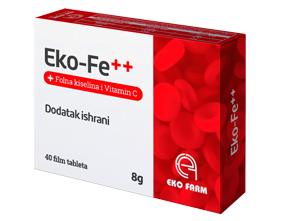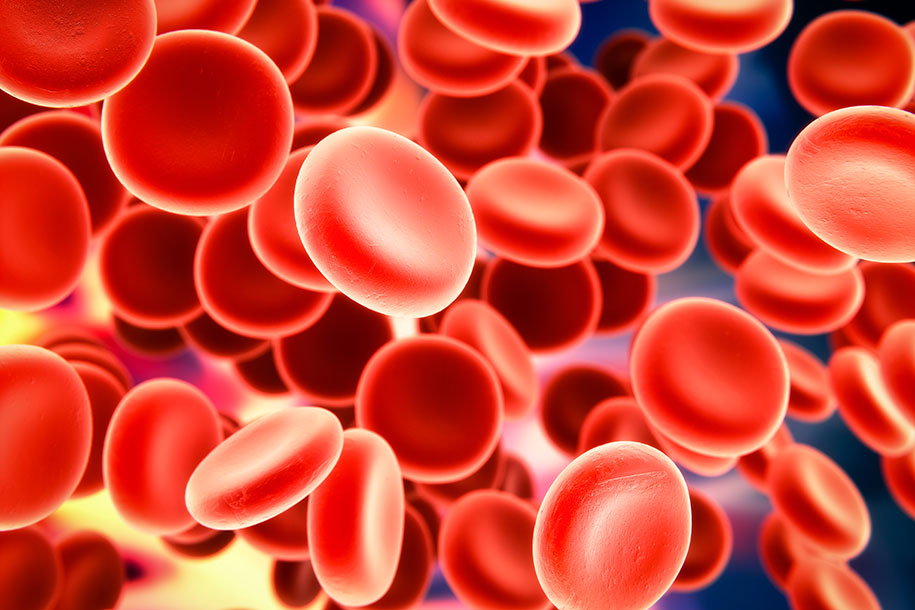Iron is a mineral that is essential for numerous vital functions in the human body. It is necessary for the biosynthesis of hemoglobin, which is a protein of the red blood cells, that carries oxygen from our lungs to all of our tissues. Highest amounts of iron in healthy adults are actually found in hemoglobin (about 70%), following by myoglobin in the muscle tissue (about 15%). All excessive amounts of iron, however, are safely stored in the form of ferritin in the liver, bone marrow and spleen, where they wait to be used again. The fact that there is no active mechanism to excrete iron from the body only proves its high biological significance. Dietary iron has two main forms: heme and nonheme. Heme iron, which is found in foods of animal origin, is better absorbed than the nonheme iron, found in foods of plant origin, iron-fortified foods and dietary supplements.
Biological activity
As a component of hemoglobin, iron plays a central role in oxygen transport, providing enough energy for all the tissues and organs of the body. In addition to that, iron provides transport and a short-term storage of oxygen to the muscles, as a component of myoglobin. It is involved in many other important biological functions, such as growth and development, reproduction, DNA synthesis, enzyme-catalysed reactions, immune system function and the synthesis of some hormones and connective tissues.
Natural sources of iron
The level of dietary iron absorption is typically low compared to the ingested amounts and it highly depends on the form of iron and the body’s need for this mineral. As previously mentioned, dietary iron has two main forms: heme and nonheme. Heme iron is more efficiently absorbed from the human gastrointestinal tract (from 15% to 35% of iron intake), therefore it has a higher bioavailability than the nonheme iron, whose absorption is usually between 10% and 20% of iron intake.
Dietary sources of heme iron include:
- meat (beef, lamb, pork)
- poultry (duck, chicken, turkey)
- organ meats (pork, chicken, turkey liver; lamb, beef, pork kidney)
- fish (mackerel, trout, seabass, canned tuna, canned sardines)
- seafood (octopus, oysters, shrimp, clams, crab)
Dietary sources of nonheme iron include:
- vegetables (spinach, tomato puree, potato, asparagus, kale)
- legumes (soybeans, white beans, green peas, lentils, chickpeas)
- nuts (almonds, hazelnuts, macadamia, pistachio nuts, cashews)
In order to prevent nutrition related iron deficiencies, various foods such as bread, cereal, and other grain products are regularly fortified with this mineral. Infant follow-on formulas, for instance, are fortified with up to 12mg of iron per liter. That is due to the fact that the breast milk’s iron content is usually not sufficient to meet the needs of infants older than 6 months, although it is absorbed almost 3 times better than the iron in formula.
A number of factors can influence iron absorption. Foods and dietary supplements containing vitamin C, meat, poultry, fish and seafood all have the ability to enhance nonheme iron absorption, when taken during the same meal. Plant phytates and tannins, on the other hand, have completely the opposite effect. Supplemental and dietary calcium (mainly from dairy products) reduces the bioavailability of both nonheme and heme iron and should be avoided for at least two hours before or after iron consumption.
In addition, people who eat a well-balanced mixed diet have lower risk of developing iron deficiency, compared to vegetarians and vegans, whose needs for iron are estimated to be 1.8 times higher.
Iron dietary supplements
Oral iron dietary supplements meet the body’s needs for this essential mineral. They are recommended for people with inadequate dietary iron intake and those who have increased needs for this mineral, such as children and adolescents during the rapid growth phase, pregnant women, nursing mothers and the elderly, due to the malabsorption. Frequently used forms of iron in dietary supplements include ferrous (+2 oxidation state) and ferric (+3 oxidation state) iron salts, such as ferrous gluconate, ferrous sulfate, ferrous fumarate, ferric citrate, and ferric sulfate. Ferrous iron salts are better absorbed than the ferric salts, due to their higher solubility, which further results in better efficiency and fewer side effects. Iron dietary supplements are usually combined with folic acid, which is necessary for the production of healthy red blood cells in the bone marrow and the development of the nervous system, as well as vitamin C, which enhances iron absorption. Iron is better absorbed on an empty stomach, therefore it should be taken before the meal. However, people who suffer from digestive disorders are recommended to take it during the meal or with a small amount of food, to avoid possible side effects such as diarrhea, abdominal pain, constipation, nausea and dark coloured or black stools.
Iron dietary supplements should be used only under a health care professional supervision, who will determine what dose and type of iron is most appropriate, depending on the patient’s individual needs. Further monitoring of blood iron levels is needed, in order to evaluate the adequate response to the therapy.
Recommended intakes
Recommendations for iron intake have been set by various national agencies. According to the U.S. Food and Nutrition Board of the Institute of Medicine, Recommended Dietary Allowances (RDAs) for iron represent the average daily level of intake, that is sufficient to meet the nutrient requirements of nearly all (97%–98%) healthy individuals. Table 1 shows the current iron RDAs for male and female nonvegetarians from 1 to 51+ years of age. The RDAs for vegetarians are estimated to be 1.8 times higher than for people who eat a mixed diet. Table 2 shows the current iron ULs (Tolerable Upper Intake Levels), which represent the maximum daily intake that is unlikely to cause adverse health effects. Intakes higher than the UL levels should be taken only under a doctor’s recommendation, in cases of iron deficiency.
Table 1: Age and gender dependent iron RDA levels for nonvegetarians
| age (years) | RDA (mg) | |||
| male | female | pregnancy | lactation | |
| 1-3 | 7 | 7 | ||
| 4-8 | 10 | 10 | ||
| 9-13 | 8 | 8 | ||
| 14-18 | 11 | 15 | 27 | 10 |
| 19-50 | 8 | 18 | 27 | 9 |
| ˃51 | 8 | 8 | ||
Table 2: Age and gender dependent iron UL levels
| age (years) | RDA (mg) | |||
| male | female | pregnancy | lactation | |
| 1-3 | 40 | 40 | ||
| 4-8 | 40 | 40 | ||
| 9-13 | 40 | 40 | ||
| 14-18 | 45 | 45 | 45 | 45 |
| >19 | 45 | 45 | 45 | 45 |
Iron deficiency
According to the WHO (World Health Organization), approximately half of all anemia cases worldwide are caused by iron deficiency. Various factors such as inadequate dietary iron intake, chronic gastrointestinal bleeding associated with gastric ulcers, duodenal ulcers, gastrointestinal cancer or gastrointestinal parasites, can lead to the development of this condition. It progresses through several stages, including mild deficiency (decreased serum ferritin levels), mild functional deficiency (depleted iron stores, usually normal hemoglobin levels, decreased plasma iron levels, elevated plasma transferrin levels) and iron deficiency anemia (decreased hematocrit and hemoglobin levels, abnormally small red blood cells).
Iron deficiency anemia (IDA) symptoms are non-specific and the condition itself usually develops slowly, therefore it can easily go unrecognized for quite some time. Milder symptoms include fatigue, pale skin, weakness, lightheadedness, sleepiness and shortness of breath. They are typically followed by more severe symptoms such as anxiety, irritability, gastrointestinal disturbances (such as constipation), impaired psychomotor and cognitive function (that can lead to learning difficulties in children), frequent infections, fast heartbeat and even hair loss. Iron deficiency anemia should only be diagnosed by a healthcare provider based on a medical history, physical exam and laboratory testing, that most commonly include evaluation of hemoglobin and hematocrit blood levels. Hemoglobin concentrations lower than 110 to 120 g/L in children under 12 years of age, under 120 g/L in adolescents and women and under 130 g/L in men often indicate the presence of IDA.
Populations at higher risk of developing iron deficiency
Adequate amounts of iron are usually obtained from a well-balanced diet in healthy individuals, who lose only small amounts of iron through sweating, urine excretion, defecation, intestinal and skin cells shedding and gastrointestinal bleeding.
However, iron losses are greater in the following population groups:
- menstruating women
- pregnant and nursing women
- infants and young children
- teenage girls
- patients with colon cancer, celiac disease, ulcerative colitis or Crohn’s disease
- people who have had gastrointestinal surgery
- frequent blood donors
- patients with chronic heart failure
- vegetarians and vegans
- children and adolescents in food-insecure households
- people with bad eating habits
- professional athletes
Iron deficiency treatment
Iron deficiency is treated by increasing body’s iron stores and eliminating initial causes of anemia. Oral iron dietary supplements are used to improve and build up iron levels and should be used for several months along with iron-rich diet and vitamin C dietary supplements. In severe cases, on the other hand, parenteral iron medication or even blood transfusion may be needed.
by: mr ph Iva Majstorović, posted on December 23, 2014
References
1. Hurrell R, Egli I. Iron bioavailability and dietary reference values.
http://www.ncbi.nlm.nih.gov/pubmed/20200263?dopt=Abstract
2. U.S. Department of Agriculture, Agricultural Research Service.
Nutrient Data Laboratory Home Page, 2013. http://ndb.nal.usda.gov/
3. World Health Organization. Worldwide Prevalence of Anaemia 1993-2005:WHO Global Database on Anaemia. World Health Organization, 2008.
http://whqlibdoc.who.int/publications/2008/9789241596657_eng.pdf
4. Mei Z, Cogswell ME, Looker AC, Pfeiffer CM, Cusick SE, Lacher DA, et al. Assessment of iron status in US pregnant women from the National Health and Nutrition Examination Survey (NHANES), 1999-2006. http://www.ncbi.nlm.nih.gov/pubmed/21430118?dopt=Abstract
5. Clark SF. Iron Deficiency Anemia. http://www.ncbi.nlm.nih.gov/pubmed/18390780?dopt=Abstract
6. Bermejo F, Garcia-Lopez S. A guide to diagnosis of iron deficiency and iron deficiency anemia in digestive diseases. http://www.ncbi.nlm.nih.gov/pubmed/19787826?dopt=Abstract
7. Bailey RL, Gahche JJ, Lentino CV, Dwyer JT, Engel JS, Thomas PR, et al. Dietary supplement use in the United States, 2003-2006. http://www.ncbi.nlm.nih.gov/pubmed/21178089?dopt=Abstract
8. Iron – Status Indicators. United States Centers for Disease Control and Prevention. http://www.cdc.gov/nutritionreport/99-02/pdf/nr_ch3.pdf
9. Dietary Supplements Fact Sheet: Iron. NIH Office of Dietary Supplements.
https://myds.nih.gov/en/content/iron-43
 Fatigue, exhaustion, apathy, shortness of breath, impaired immunity are all difficulties of modern life that we experience more often. We attribute them to the urban, fast lifestyle, excessive work duties, nervous tension, irregular diet, and spending time indoors, not knowing that they often have quite another cause – the lack of iron in the body.
Fatigue, exhaustion, apathy, shortness of breath, impaired immunity are all difficulties of modern life that we experience more often. We attribute them to the urban, fast lifestyle, excessive work duties, nervous tension, irregular diet, and spending time indoors, not knowing that they often have quite another cause – the lack of iron in the body.
